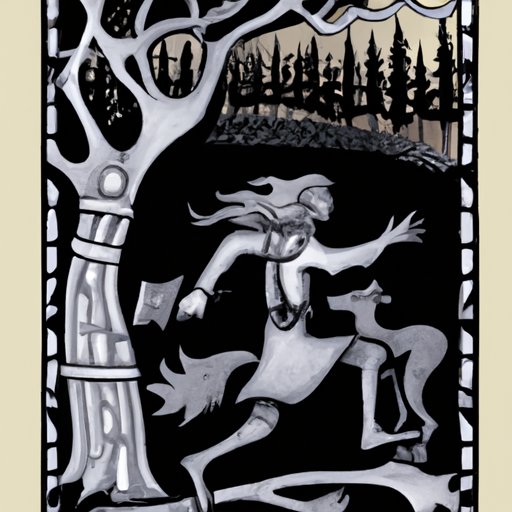Introduction
Allegory is a literary device used to convey a hidden or underlying meaning through symbols. Throughout history, authors have used allegory to impart important meanings and messages to readers. In this article, we’ll explore the definition and examples of allegory in literature, the forms it takes and how it has evolved over time. We’ll also investigate the impact of allegory on modern literature, examining the ways in which authors continue to use allegorical symbolism to convey meaningful messages.

Definition and Examples of Allegory in Literature
Allegory is defined as “a representation of an abstract or spiritual meaning through concrete or material forms; figurative treatment of one subject under the guise of another.” This type of symbolism allows authors to express complex ideas in a more direct manner. Allegory has been used for centuries to convey moral lessons, political and religious messages, and philosophical concepts.
One of the most famous examples of allegory in literature is John Bunyan’s The Pilgrim’s Progress (1678). In this work, Bunyan tells the story of Christian, a pilgrim who embarks on a journey from his home to the Celestial City. Along the way, he encounters various people and obstacles, each of which represent a spiritual truth or lesson. By using allegorical symbolism, Bunyan was able to communicate spiritual truths in a more accessible way.
Forms of Allegory in Literature
There are several different forms of allegory that authors use to convey their messages. Here are some of the most common types:
Personification
Personification is a type of figurative language in which abstract concepts are represented as living beings, such as animals or people. Personification can be used to represent an idea or emotion. For example, in William Wordsworth’s poem, “The World Is Too Much With Us,” the poet personifies Nature as a female figure, describing her as “great Mother” and “the sea that bares her bosom to the moon.” Through this imagery, Wordsworth conveys a sense of awe and reverence for Nature.
Fable
A fable is a short story that typically features animal characters who are endowed with human qualities. The purpose of a fable is to teach a moral lesson. One of the most famous examples of a fable is Aesop’s “The Tortoise and the Hare.” In this story, a speedy hare challenges a slow tortoise to a race. Despite the hare’s advantage, the tortoise wins the race by taking his time and staying focused on the goal. The moral of the story is that slow and steady wins the race.
Parable
A parable is a brief story that is intended to illustrate a moral or spiritual lesson. Parables often feature characters who represent abstract concepts, such as faith or charity. One of the most famous parables is Jesus’ parable of the Good Samaritan, which tells the story of a man who stops to help a stranger in need. By telling this story, Jesus emphasizes the importance of showing kindness to others.
Myth
A myth is a traditional story that features gods, goddesses and other supernatural beings. Myths often explain natural phenomena or reveal cultural values and beliefs. One of the most well-known myths is the Greek myth of Prometheus, which tells the story of a Titan who gave humans the gift of fire. By telling this story, the ancient Greeks sought to explain the origin of fire and to emphasize the power of human ingenuity.

The Use of Allegory to Convey Meaningful Messages
Allegorical symbolism can be used to convey complex ideas and messages in a more direct and concise manner. Authors often use allegory to explore themes of morality, justice and faith. By using allegory, authors can unpick the complexities of a particular issue and explore multiple perspectives.
For example, George Orwell’s Animal Farm is an allegorical novel that uses animal characters to explore the Russian Revolution and the rise of Stalinism. The novel follows the animals of Manor Farm, who overthrow their oppressive human masters and establish a new government. Throughout the novel, Orwell uses allegory to examine the dangers of totalitarianism and the importance of freedom and democracy.

Analyzing the Impact of Allegory on Modern Literature
Today, allegory is still widely used in literature to convey meaningful messages. Many popular books and movies employ allegorical symbolism to explore complex themes and issues. For instance, Suzanne Collins’ Hunger Games trilogy uses allegory to explore the consequences of authoritarianism and the importance of rebellion. Similarly, the classic film The Wizard of Oz employs allegory to explore the themes of courage and self-discovery.
In addition to books and movies, allegory is also used in television shows, comic books and video games. For example, the popular video game series Metal Gear Solid uses allegory to explore the danger of nuclear weapons and the importance of peace. By using allegorical symbolism, authors are able to communicate powerful messages in an accessible and engaging way.
Conclusion
Allegory has been used for centuries to convey powerful messages and themes in literature. From personification to myths, authors have employed various forms of allegory to impart moral lessons, political and religious messages, and philosophical concepts. Today, allegory remains an important tool for authors seeking to explore complex issues in a more direct and engaging manner. By using allegorical symbolism, authors can communicate meaningful messages and impart valuable lessons to readers.
(Note: Is this article not meeting your expectations? Do you have knowledge or insights to share? Unlock new opportunities and expand your reach by joining our authors team. Click Registration to join us and share your expertise with our readers.)
